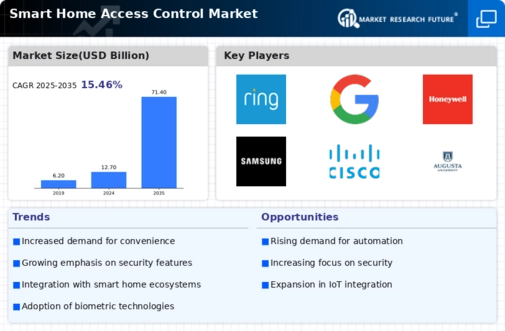Market Growth Projections
The Global Smart Home Access Control Market Industry is poised for substantial growth, with projections indicating a market value of 12.7 USD Billion in 2024 and an anticipated increase to 71.4 USD Billion by 2035. This growth represents a compound annual growth rate (CAGR) of 16.99% from 2025 to 2035. The increasing adoption of smart home technologies, coupled with rising consumer awareness regarding security and convenience, is likely to drive this expansion. As more households integrate smart access control systems into their daily lives, the market is expected to flourish, reflecting a broader trend towards smart living.
Growing Awareness of Energy Efficiency
The rising emphasis on energy efficiency is influencing the Global Smart Home Access Control Market Industry. Smart access control systems often come with features that optimize energy consumption, such as automated locking mechanisms and remote access capabilities. Homeowners are increasingly aware of the environmental impact of their choices and are seeking solutions that align with sustainable practices. This shift not only contributes to energy savings but also enhances the overall appeal of smart home technologies. As energy-efficient solutions gain traction, they are likely to drive further adoption of smart access control systems.
Integration with Smart Home Ecosystems
The integration of access control systems with broader smart home ecosystems is a significant driver for the Global Smart Home Access Control Market Industry. Consumers are increasingly looking for solutions that seamlessly connect with other smart devices, such as cameras, alarms, and lighting systems. This interoperability enhances user experience and convenience, allowing homeowners to manage their security from a single platform. As more manufacturers focus on creating compatible devices, the market is expected to expand. This trend is indicative of a shift towards holistic smart home solutions, which could lead to a projected market value of 71.4 USD Billion by 2035.
Rising Demand for Home Security Solutions
The increasing concern for home security is a primary driver of the Global Smart Home Access Control Market Industry. As urbanization continues to rise, homeowners are increasingly investing in advanced security systems to protect their properties. In 2024, the market is projected to reach 12.7 USD Billion, reflecting a growing awareness of security threats. This trend is further supported by the proliferation of smart devices, which allow for remote monitoring and control. Homeowners are seeking integrated solutions that provide convenience and peace of mind, thereby driving the demand for smart access control systems.
Regulatory Support for Smart Home Technologies
Government initiatives and regulations promoting smart home technologies are significantly impacting the Global Smart Home Access Control Market Industry. Many countries are implementing policies that encourage the adoption of smart technologies for enhanced security and energy efficiency. This regulatory support fosters innovation and investment in the sector, leading to the development of new products and solutions. As governments recognize the potential benefits of smart home technologies, they are likely to create a favorable environment for market growth. This trend may further accelerate the market's expansion in the coming years.
Technological Advancements in Smart Home Devices
Technological innovation plays a crucial role in shaping the Global Smart Home Access Control Market Industry. The advent of IoT and AI technologies has enabled the development of sophisticated access control systems that offer enhanced functionality and user experience. For instance, biometric authentication and facial recognition technologies are becoming increasingly common, providing higher security levels. These advancements not only improve the efficiency of access control but also appeal to tech-savvy consumers. As these technologies evolve, they are likely to attract more users, contributing to the market's growth trajectory.













